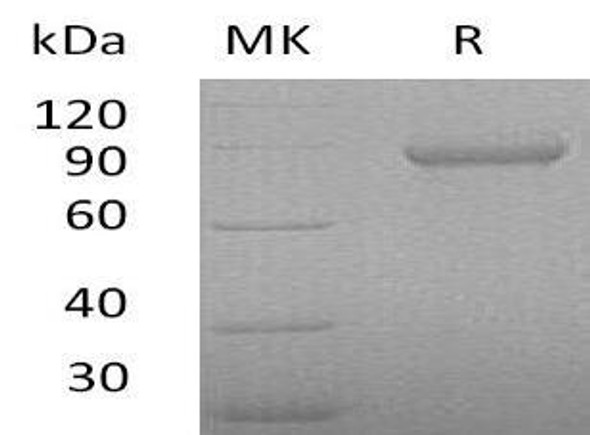Human Periostin Recombinant Protein (RPPB0851)
- SKU:
- RPPB0851
- Product Type:
- Recombinant Protein
- Species:
- Human
- Uniprot:
- Q15063
- Research Area:
- Growth Factors & Cytokines
Description
| Product Name: | Human Periostin Recombinant Protein |
| Product Code: | RPPB0851 |
| Size: | 10µg |
| Species: | Human |
| Target: | Periostin |
| Synonyms: | OSF-2, Periostin, Osteoblast Specific Factor 2, PN OSF-2, PDLPOSTN, POSTN, MGC119510, MGC119511, PN, RP11-412K4.1. |
| Source: | HEK293 Cells |
| Physical Appearance: | Filtered White lyophilized (freeze-dried) powder. |
| Formulation: | Periostin was filtered (0.4 �m) and lyophilized from 0.5mg/ml solution in phosphate buffered saline and 5% trehalose. |
| Solubility: | It is recommended to add deionized water to prepare a working stock solution of approximately 0.5 mg/ml and let the lyophilized pellet dissolve completely. Periostin is not sterile! Please filter the product by an appropriate sterile filter before using it in the cell culture. |
| Stability: | Store lyophilized protein at -20°C. Aliquot the product after reconstitution to avoid repeated freezing/thawing cycles. Reconstituted protein can be stored at 4°C for a limited period of time. |
| Purity: | Greater than 38.0% as determined by SDS-PAGE. |
| Amino Acid Sequence: | NNHYDKILAH SRIRGRDQGP NVCALQQILG TKKKYFSTCK NWYKKSICGQ KTTVLYECCP GYMRMEGMKG CPAVLPIDHV YGTLGIVGAT TTQRYSDASK LREEIEGKGS FTYFAPSNEA WDNLDSDIRR GLESNVNVEL LNALHSHMIN KRMLTKDLKN GMIIPSMYNN LGLFINHYPN GVVTVNCARI IHGNQIATNG VVHVIDRVLT QIGTSIQDFI EAEDDLSSFR AAAITSDILE ALGRDGHFTL FAPTNEAFEK LPRGVLERIM GDKVASEALM KYHILNTLQC SESIMGGAVF ETLEGNTIEI GCDGDSITVN GIKMVNKKDI VTNNGVIHLI DQVLIPDSAK QVIELAGKQQ TTFTDLVAQL GLASALRPDG EYTLLAPVNN AFSDDTLSMD QRLLKLILQN HILKVKVGLN ELYNGQILET IGGKQLRVFV YRTAVCIENS CMEKGSKQGR NGAIHIFREI IKPAEKSLHE KLKQDKRFST FLSLLEAADL KELLTQPGDW TLFVPTNDAF KGMTSEEKEI LIRDKNALQN IILYHLTPGV FIGKGFEPGV TNILKTTQGS KIFLKEVNDT LLVNELKSKE SDIMTTNGVI HVVDKLLYPA DTPVGNDQLL EILNKLIKYI QIKFVRGSTF KEIPVTVYTT KIITKVVEPK IKVIEGSLQP IIKTEGPTLT KVKIEGEPEF RLIKEGETIT EVIHGEPIIK KYTKIIDGVP VEITEKETRE ERIITGPEIK YTRISTGGGE TEETLKKLLQ EEVTKVTKFI EGGDGHLFED EEIKRLLQGD TPVRKLQANK KVQGSRRRLR EGRSQHHHHH H |
Periostin is a disulfide linked 90 kDa, 811 amino acid protein originally isolated as a osteoblast-specific factor that functions as a cell adhesion molecule for preosteoblasts and is thought to be involved in osteoblast recruitment, attachment and spreading. Additionally, periostin expression has previously been shown to be significantly increased by both transforming growth factor beta-1(TGFbeta1) and bone morphogenetic protein (BMP-2). OSF-2 has a typical signal sequence, followed by a cysteine-rich domain, a fourfold repeated domain and a C-terminal domain. The fourfold repeated domain of OSF-2 shows homology with the insect protein fasciclinPeriostin mRNA is expressed in the developing mouse embryonic and fetal heart, and that it is localized to the endocardial cushions that ultimately divide the primitive heart tube into a four-chambered heart.
Periostin Human Recombinant produced in HEK cells is a single, glycosylated, polypeptide chain (Asn22-Gln836) containing a total of 821 amino acids, having a calculated molecular mass of 91.8kDa and fused to a 6 aa His tag at C-Terminus.
| UniProt Protein Function: | POSTN: Binds to heparin. Induces cell attachment and spreading and plays a role in cell adhesion. May play a role in extracellular matrix mineralization. 4 isoforms of the human protein are produced by alternative splicing. |
| UniProt Protein Details: | Protein type:Motility/polarity/chemotaxis; Cell adhesion; Secreted, signal peptide; Secreted Chromosomal Location of Human Ortholog: 13q13.3 Cellular Component: extracellular matrix; extracellular space; proteinaceous extracellular matrix; trans-Golgi network Molecular Function:heparin binding; protein binding; cell adhesion molecule binding Biological Process: tissue development; extracellular matrix organization and biogenesis; regulation of Notch signaling pathway; cell adhesion; skeletal development |
| NCBI Summary: | This gene encodes a secreted extracellular matrix protein that functions in tissue development and regeneration, including wound healing, and ventricular remodeling following myocardial infarction. The encoded protein binds to integrins to support adhesion and migration of epithelial cells. This protein plays a role in cancer stem cell maintenance and metastasis. Mice lacking this gene exhibit cardiac valve disease, and skeletal and dental defects. Alternative splicing results in multiple transcript variants encoding different isoforms. [provided by RefSeq, Sep 2015] |
| UniProt Code: | Q15063 |
| NCBI GenInfo Identifier: | 93138709 |
| NCBI Gene ID: | 10631 |
| NCBI Accession: | Q15063.2 |
| UniProt Secondary Accession: | Q15063,Q15064, Q29XZ0, Q3KPJ5, Q5VSY5, Q8IZF9, B1ALD8 C0IMJ1, C0IMJ2, C0IMJ4, D2KRH7, F5H628, |
| UniProt Related Accession: | Q15063 |
| Molecular Weight: | 80,357 Da |
| NCBI Full Name: | Periostin |
| NCBI Synonym Full Names: | periostin, osteoblast specific factor |
| NCBI Official Symbol: | POSTN�� |
| NCBI Official Synonym Symbols: | PN; OSF2; OSF-2; PDLPOSTN; periostin�� |
| NCBI Protein Information: | periostin; periodontal ligament-specific periostin; osteoblast specific factor 2 (fasciclin I-like) |
| UniProt Protein Name: | Periostin |
| UniProt Synonym Protein Names: | Osteoblast-specific factor 2; OSF-2 |
| Protein Family: | Periostin |
| UniProt Gene Name: | POSTN�� |
| UniProt Entry Name: | POSTN_HUMAN |









